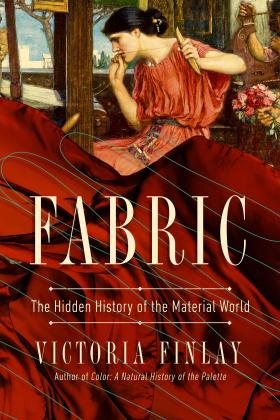
| Format | Hardcover |
| Publication Date | 06/07/22 |
| ISBN | 9781639361632 |
| Trim Size / Pages | 6 x 9 in / 528 |
A magnificent work of original research that unravels history through textiles and cloth—how we make it, use it, and what it means to us.
A New York Times Book Review Editor's Choice
How is a handmade fabric helping save an ancient forest?
Why is a famous fabric pattern from India best known by the name of a Scottish town?
How is a Chinese dragon robe a diagram of the whole universe?
What is the difference between how the Greek Fates and the Viking Norns used threads to tell our destiny?
In Fabric, bestselling author Victoria Finlay spins us round the globe, weaving stories of our relationship with cloth and asking how and why people through the ages have made it, worn it, invented it, and made symbols out of it. And sometimes why they have fought for it.
She beats the inner bark of trees into cloth in Papua New Guinea, fails to handspin cotton in Guatemala, visits tweed weavers at their homes in Harris, and has lessons in patchwork-making in Gee's Bend, Alabama - where in the 1930s, deprived of almost everything they owned, a community of women turned quilting into an art form.
She began her research just after the deaths of both her parents —and entwined in the threads she found her personal story too. Fabric is not just a material history of our world, but Finlay's own journey through grief and recovery.
Victoria Finlay is the critically acclaimed author of Color:Travels Through the Paintbox and the former arts editor of the South China Morning Post. She studied social anthropology and has travelled around the world in search of stories about her subjects, from colour to jewels and fabric. As well as writing, she has worked in international development.
Buy it now in print: Amazon Barnes & Noble IndieBound
Buy it now in ebook: Amazon Barnes & Noble Apple Kobo
"This exuberant history of textiles grew out of the author’s hunger to learn about the links that 'the material we can see has with the non-material world we cannot see.” The New Yorker
"In Fabric: The hidden history of the material world, Victoria Finlay wants to recover 'the truth in fabric.' Her sprawling book, part history, part travelogue and part memoir, takes her from Papua New Guinea to Paisley in search of the materials, processes and meanings of ten types of cloth." Times Literary Supplement
"Finlay’s writing is at once technical, historical and deeply personal. Like a skilled weaver, she takes many disparate threads and constructs a compelling narrative as informative as it is emotionally engaging. Part historical survey, part memoir and part travelogue, Fabric follows Finlay as she discovers the secrets behind each material’s history — all written as she mourned the deaths of her parents." New York Times Book Review, Editor's Choice
"Fabric bundles history, travelogue, and memoir, flowing easily between exposition, narrative, and intimate accounts of Finlay's travels and her grief. The writing is authoritative and engaging, packed with memorable vignettes and trivia." Booklist
"Subtle, compendious and rich, if this was just a cultural history of fabric it would be a fine piece of work. But Finlay weaves another story into the book: she is grieving for her mother. More often the book acquires an extra dimension; the effect that springs to mind is the strange iridescence of that twin-coloured silk you sometimes find as the lining of a suit jacket. This book recovers that relatively silenced or at least sidelined history. It is an emotive and serious work of what you might call history on the distaff side." The Sunday Times (UK)
"Victoria Finlay’s Fabric: The Hidden History of the Material World is itself a beautiful tapestry of a work, woven together to unfold a hidden but powerful history of fabrics. Yet the book is more than a history of fabrics—it draws out the human spirit and culture deeply embedded in fabric making, from simple sewing to more technological production. Finlay engages the reader through personal trajectories, keen observations, interesting historical narratives and illustrative examples." The Englewood Review of Books